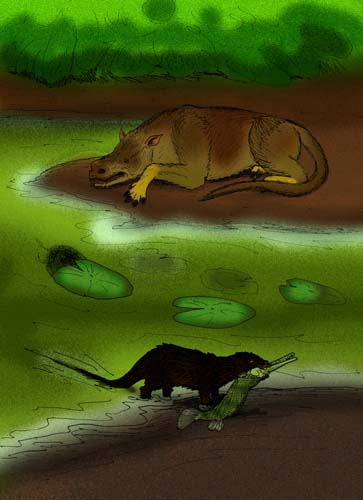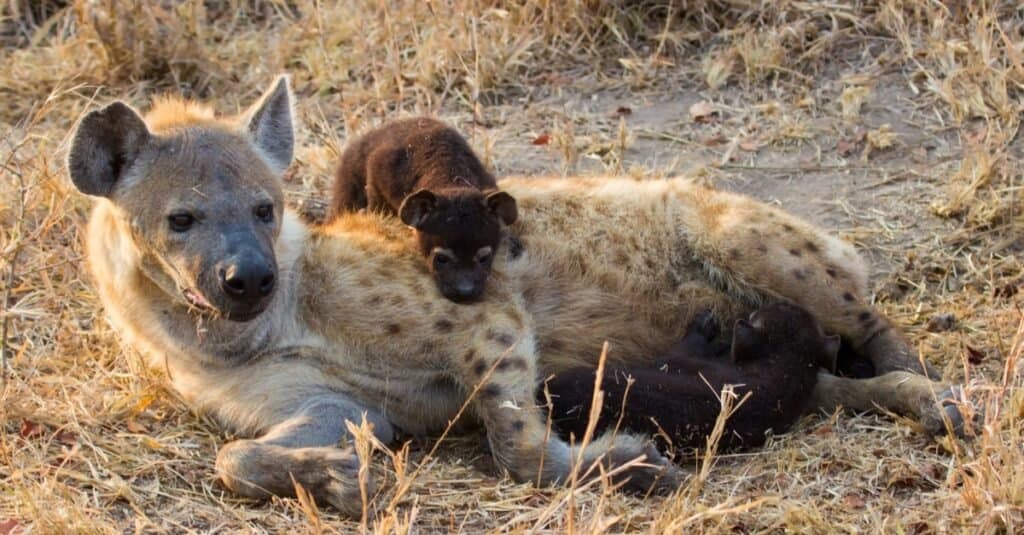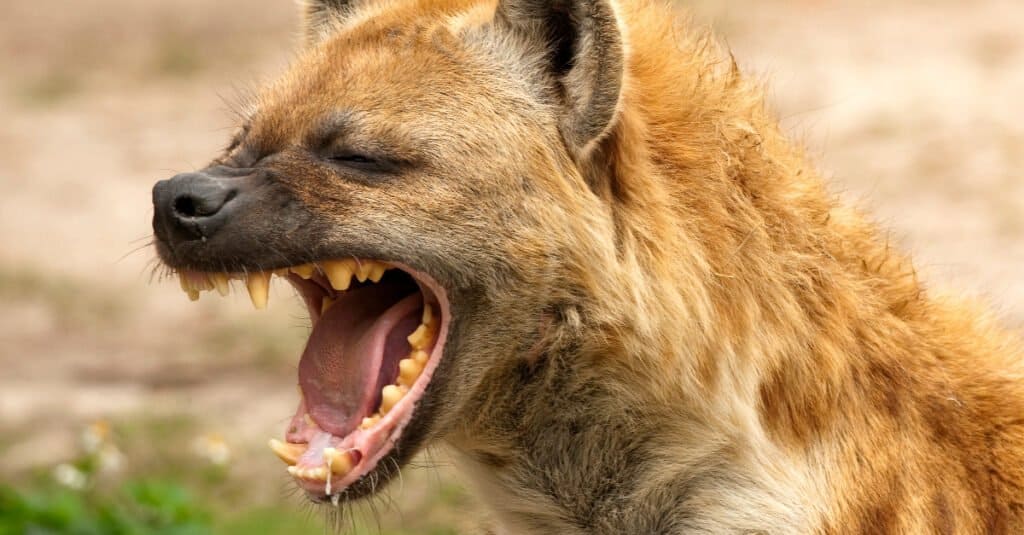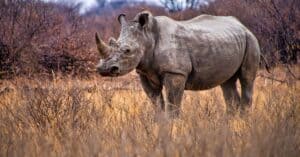The modern-day laughing hyena is maybe one of the most famous animals in Africa. These yelping, fearsome creatures have been featured in documentaries and even massive animated hits like The Lion King. Even humans living thousands of miles away in North America could probably identify the yipping noises of a hyena. Still, as scary as they may be, there was an ancient ancestor to the hyena that is even more terrifying. Let’s meet the “thick hyena” with stripes that grew as big as a bear.
Pachyaena, One of the Earliest Ancestors of Modern Carnivores

translates as “thick hyena” and looks like a prehistoric version of one.
©Ghedoghedo / CC BY-SA 3.0 – License
One of the earliest ancient ancestors of modern carnivores is a large, short-legged mammal known as Pachyaena.
Pachyaena gets its name from its appearance. Directly translated, Pachyaena means “thick hyena,” which is a reference to its short, heavily built stature that closely resembles modern-day hyenas. Despite resembling hyenas, Pachyaena actually predates them by millions of years. In fact, Pachyaena evolved before modern hoofed animals or carnivores ever stepped foot (or hoof) on the scene. Instead, Pachyaena has characteristics of both since it is the ancient ancestor of both.
Appearance

had a similar body type to the modern-day tapir.
©Stanton F. Fink at en.wikipedia / CC BY 3.0 – License
As the name suggests, Pachyaena was built like a hyena. It was heavily built and had short, stocky legs. Some of the fossil evidence points to paraxonic compressed feet, meaning that they had small feet with two toes that bore the weight of the animal. In the case of Pachyaena, this meant that it was well-adapted to run. In regards to evolutionary history, this trait is the predecessor to predators that run to chase prey, as well as ungulates that run away from predators.
Appearance-wise, Pachyaena probably looked like a mixture of a hyena and an opossum (or a tapir from South America). Scientific depictions of Pachyaena display it as brown, although it may have had stripes.
Size

Scientists believe that Pachyaena was larger than modern-day hyenas.
©Alta Oosthuizen/Shutterstock.com
Pachyaena was likely much larger than modern-day hyenas are. Based on fossil evidence, most examples of Pachyaena ranged from the size of a coyote to the size of a bear. Using measurements based on the femur bones from fossils, Pachyaena gigantea (the largest member of the Pachyaena genus), the animal would have been around 180 lbs. Still, other scientists debate this number and place the weight range for these creatures between 284 and 875 lbs, both of which are substantially larger than the 180 lbs commonly cited.
An Endurance Hunter

was an early endurance hunter that ran after its prey.
©iStock.com/dlrz4114
Endurance hunting (persistence hunting) by mammals wasn’t something that occurred until much more recently in evolutionary history. Pachyaena, however, was one of the earliest examples of how successful this tactic could be. With its compressed and specialized feet, elongated lower sections of its limbs, and joints restricted to certain planes, Pachyaena was clearly built for distance, not speed.
These hunters would have chased prey down until exhausted, similar to how humans, wolves, and other apex predators operate today. Once Pachyaena locked onto you, you may be able to outrun it temporarily, but it would eventually catch you! The strategy is so effective that even humans use it today!
Endurance running may have had adaptive value not only in scavenging but also in persistence hunting. Before the domestication of dogs, persistence hunting may have been one of the most efficient forms of hunting and may therefore have been crucial in the evolution of humans.
The University of Chicago
Where Was Pachyaena Found?

The first fossils of
Pachyaenawere discovered in rock outcrops in Wyoming, where the ancient creature used to live.
©iStock.com/ChrisB
Pachyaena was first discovered from skeletons and skulls, especially that of the jawbone. Although there are many species within the Pachyaena genus, three of them were located within the Willwood formation located in modern-day Wyoming.
Pachyaena likely didn’t evolve in North America, however. Its fossil record shows that it probably came from Asia and spread to Europe as its population grew. Eventually, it was able to cross into North America from a land bridge that probably existed in the North Atlantic Ocean. This would have taken place during the Paleocene and Early Eocene periods. The earliest examples of the genus (estimated to be during the Late Paleocene) are located in Mongolia, leading to the belief that it first evolved in that region as opposed to North America.
The photo featured at the top of this post is © iStock.com/ACS15
Thank you for reading! Have some feedback for us? Contact the AZ Animals editorial team.






